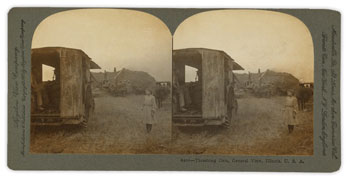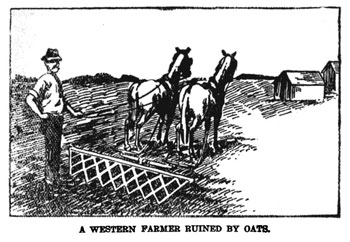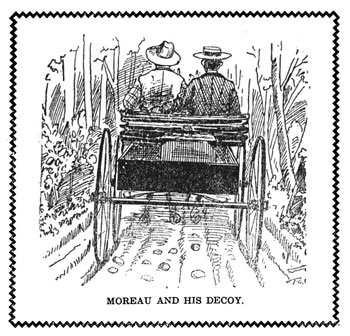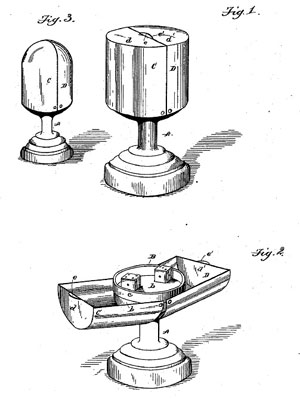In the Archives: Sowing Bogus Oats
The well-dressed stranger standing in the driveway certainly had the farmer’s attention. The stranger’s eyes flicked over one of the farmer’s suspenders fastened to faded trousers with a nail as he described his generous proposition. The farmer glanced at the visitor’s handsome buggy – this was a gentleman of means, offering a poor man a shot at paying off the mortgage. After a handshake, the stranger retrieved some papers from his buggy and held out a pen.
In the mid-1880s, one fraudulent scheme snookered thousands of Michigan farmers across the lower half of the lower peninsula, including many in Washtenaw County. As the fraud spread like a storm over sixteen Michigan counties, it left farmers crushed by debt, newspapers issuing shrill warnings, and a rising tide of lawsuits that crested not once but several times in the Michigan Supreme Court.
The miracle product responsible for ruination was the fabled “Bohemian oats,” a variety of oat touted as far more valuable than the regular oats then for sale from 35 to 50 cents a bushel in southeastern Michigan.
Scamming Oats
With minor variations the proposition was this: the “oat company agent” offered to sell the farmer 10 bushels of Bohemian oats for $10 per bushel. The farmer would grow and harvest the crop, at which time the agent would buy 20 bushels of the oats for $10 per bushel, minus a reselling percentage. For an investment of $100, the farmer would make nearly $100 in pure profit. One-hundred dollars in 1885 Michigan – equivalent to $2,500 today – was enough to buy a decent farm horse
If the farmer agreed, the agent would present him with a contract with an “abundance of red and green inks, [a] very broad seal (intended to look like gold, but . . . only Dutch metal) and the bold signature of a secretary [of the agent’s purported oat company] . . . ” according to the March 1886 issue of the American Agriculturist. The farmer signed the bond – the agent did not. The farmer rarely paid in cash, but with a promissory note to be paid one year later, when he received the agent’s payment for the oat crop.
It was at this point that the scheme took one of several paths.
Sometimes the agent showed up at harvest time, collected the oats, and paid the farmer not in cash but in his own promissory notes, which turned out, at the bank, to be worthless.
Other times the agent, instead of holding the promissory note for a year, would sell it to a bank. An unsuspecting bank customer might buy it for face value, trusting in the farmer’s good name, and later try to cash it. But the farmer couldn’t redeem the note prematurely without the largesse from the oat crop.
He had to either sell off some stock animals, perhaps the very ones that enabled him to plow, or plead unable to pay, which often led to a lawsuit from the note’s purchaser. A third option for less scrupulous farmers was to try to pawn off the oats to his neighbors, perhaps while brandishing the gloriously colored and impressive certificate from the agent, to demonstrate the oat company’s authenticity.
Marketing the Oat Scam
A third strategy extended over the span of two years, as detailed in Willard Tucker’s 1913 book “Gratiot County Michigan.” The agent breezed into the county and signed up several of the more prominent farmers for the oat deal. When the crop was harvested, the agent duly paid per the agreement
Then he published an ad touting testimonials from these respectable and prosperous men. One Robert Smith was quoted as saying that Bohemian oats were “the best and most profitable branch of farming that they had ever engaged in.” The ad was read with interest by numerous other Gratiot county farmers.
The ad did not go unnoticed by newspapers. The Nov. 20, 1885 Marshall Statesman wrote, “The Bohemian oats agents in Gratiot county are so audacious that they actually advertise in the local papers the list of their victims.”
“And the farmers fell over one another in their anxiety to get some of those oats,” continued Tucker, “and to give their notes for them at $10 a bushel.” The farmers showered the agent with promissory notes and planted their crop.
This time, the agent quietly laundered the pile of notes at a bank and wafted away.
Newspapers all over Michigan watched this ongoing pillage of local farms with mounting frustration. Editorial after editorial had gone for nought.
The March 12, 1886 Marshall Statesman wrote: “Parties about Morenci [Lenawee County] who have been duped by the Bohemian oats scheme into giving notes have banded themselves together to resist payment of said notes. It is wonderful how many dupes the swindlers can make in this reading age, when the papers have so long been filled with exposure.”
A May 1886 issue of the Ovid [Clinton County] Union, which had railed against the scheme, said, “[Some farmers who] thought they were too poor to pay 75 cents a year for the Union . . . will have to pay Bohemian oat notes to the extent of several hundred dollars. You see the point?”
Women v. Bogus Oats
Not everyone fell for the scam. Some starry-eyed farmers were dissuaded by flinty-eyed wives.
In his 1907 memoir “Swindling Exposed, from the Diary of William B. Moreau, King of Fakirs,” the author wrote of his experience shilling Bohemian oats. “The first farmer we came to listened to us, and there is little doubt of our bagging him were it not for his wife, who called him one side, and then the jig was up. We never tried to work a man after he consulted with his wife, unless she also fell into the trap, which was seldom the case. Rather cast down in spirits, [we] drove away . . . ”
The Feb. 11, 1887 issue of the Marshall Statesman reported, “The fact that Farmer Courtright, who lives near Lansing, is confined to his bed by serious illness, did not prevent a Bohemian oats agent calling this week, and demanding payment of a $160 note. Nor was Mrs. Cartwright prevented from settling the business by catching the agent by the slack of his coat, getting possession of the note and tearing it into fragments, and then walking the fellow out of the house, too quick.”
Other schemes of the day evolved to target women. One Mrs. R. F. Johnston gave a Jan. 23, 1885 talk at the Monroe Institute about the deceptive nature of work-at-home schemes marketed to housewives. One of these was the processing of silk cocoons. “Those who have tried it report very hard work, no play, and very poor pay. The money seems to be gathered in by those who have the silkworm eggs and the Russian mulberry for sale,” said Mrs. Johnson. “When the cocoons are spun and steamed and packed, and express charges paid to Philadelphia, and the association fails to remit at all, or pays only half schedule value, one is inclined to believe there must be some ‘Bohemian oats’ about the scheme.” The term had become derisive slang.
Origin of Bogus Oats and Beyond
Other farmers figured out for themselves that Bohemian oats were a scam. As noted by the February 6, 1885 Marshall Statesman: “Bohemian oats fiends undertook to convince farmer Graves of Washtenaw county, that he needed a supply of their choice seed. Farmer Graves meandered to the house, came out loaded with a shotgun and other implements of war, and informed the fiends that he was subject to fits of temporary insanity, whereupon they left for parts unknown quickly and without ceremony.”
The culprit may have been one Alfred Hammer, who in 1884 organized a company called the Ypsilanti Bohemian Oats and Cereal Company, a mysterious concern that is not listed in mid-1880s Ypsilanti city directories. Hammer’s venture was short-lived; he was arrested in Flint for oat fraud and after a two-day-long trial, sentenced to either two years in prison or a $250 fine. Hammer paid the fine.
Many other lawsuits filled Michigan courts at the local, circuit court, and Supreme Court level. The Michigan legislature acted and in 1887 with the approval of Governor Luce passed the “Bohemian Oats Bill,” which made it a felony for anyone to take a note or receipt for the sale of grains at a “fictitious price,” defined as twice the going market rate or greater. Iowa and Ohio passed similar laws.
By the late 1880s when the scheme had petered out, the loss was counted in hundreds of thousands of dollars to Michigan farmers. Berrien county farmers paid $1,000 for oats in 1885 [$25,000 in today’s money]. Farmers in Eaton Rapids lost $35,000 [$863,000]. Livingston County farmers lost $100,000 [$2,500,000]. The Ypsilanti company is said to have cleared a tidy $100,000.
Michigan was not the only state affected. Similar Bohemian oat swindles were reported from Indiana, Iowa, Ohio, Missouri, Pennsylvania, New York, West Virginia, Kansas, Nebraska, and a few in Kentucky, Tennessee, and the Dakota Territory. Even Connecticut and Maine, hardly grain belt states, each reported one fraud case.
When Bohemian oats had run their course, swindlers turned to other ingenious schemes. Some involved other exotically-named strains of barley, oats, and wheat. Others branched out into other farm products. “The Bohemian oats scheme has recently been o’ershadowed by a new scheme, which for unadulterated, galvanized ‘cheek,’ is entitled to the first prize,” said the April 16, 1886 Marshall Daily Chronicle. “An oily-tongued individual offers for sale Plymouth Rock eggs for $75 per dozen, and agrees to buy all chickens hatched from these eggs for $100 each. The fact that these eggs are pretty thoroughly boiled does not seem to interfere in the least with the sharper’s success.”
One well-known scam throughout the Midwest involved lightning rods. A salesman promised to install lightning rods on a farmer’s house and barn for a fixed cost. A tiny clause in the contract stipulated an extra fee if the collective length of the rods happened to accidentally run a bit over the agreed length. One Indiana farmer who signed up had second thoughts and ran to town to consult an attorney. “Upon returning,” said the Oct. 26, 1895 Goshen Weekly News, “he found his buildings bristling with lightning rods so that a bolt could not get between them to the buildings.”
The ingenuity of scoundrels perpetrates scams to this day, but 19th-century Michigan farmers also had their full share.
Mystery Artifact
In the most recent column, Donna Estabrook guessed that the item in question was kitchen tongs.
That is what I believe they are. I’m not 100% sure, however, and if corrected would be grateful for the information.
This Mystery Object was invented by an Ann Arborite, but what might it be? Take your best guess and good luck!
Laura Bien is assistant editor at Michigan History Magazine. Contact her at ypsidixit@gmail.com.
The Chronicle relies in part on regular voluntary subscriptions to keep us from falling prey to Bohemian news sales pitches. If you’re already supporting The Chronicle, please encourage your friends, neighbors and coworkers to do the same. Click this link for details: Subscribe to The Chronicle.








Glad to see you back, Laura!
The things people will do to make a buck–that is so horrible! But today we still have scams, just a little more sophisticated (maybe!). I always cringe when my Facebook gives me a “work at home! Make $70/hour!” ad. I guess people still fall for those things though….
The threshing stereogram converted for red/blue glasses, for those who have them: pic.twitter.com/AfHSpYp5
A mechanical dice roller for a lazy Craps player?
Messed up link: pic.twitter.com/xxRGmCFD
It looks like a device for throwing dice, although I can’t imagine why you’d need that. Maybe for some place like a train where there is little flat surface and the dice could get away.
A clue is found in the Ann Arbor Argus, November 6, 1894.
Here’s the link again to the 3D-image cosmonıcan made for those with red-blue glasses: [link] Thanks, cosmonıcan! (I love wearing 3D glasses to look at images on my computer.)
What fun!
Hi everyone; thank you for reading my story! I would like to apologize to you if you have been looking for my stories for the past few months. I had a medical issue I was dealing with since an August diagnosis. It’s over with now, and I am grateful to my editor for his kindness in allowing me some time off to recuperate. Thanks to all of you. I am grateful for your reading my pieces.
TeacherPatti: Thank you for your kind words. As it happens, work-at-home schemes were perhaps just as popular in the late 19th century as today and I might make that my topic for the next article. The silk-processing offer mentioned above is just one of many such scams.
Cosmonican: Wow, thank you for doing that! I happen to keep a pair of red-blue 3D glasses in with a bad of address labels…your 3D version really makes the foreground wagon and little girl pop out! Very neat!
Jim: Hmm, we shall see. :)
Edward: Perhaps you are thinking about the AADL “Old News” site? A great resource!
Vivienne: Thanks for reading!
What part of Washtenaw county was farmer Graves from? I remember that Bird Hills Park, or a portion, was once called Graves Woods, is there a possible connection or was he elsewhere in the county?